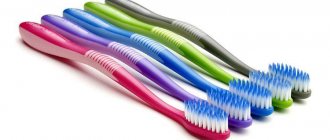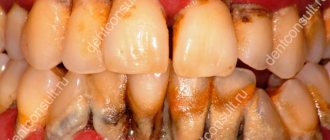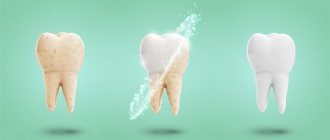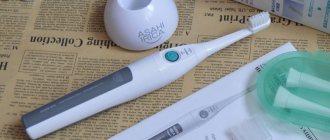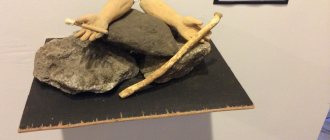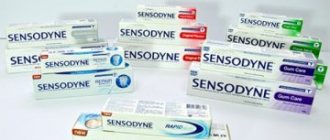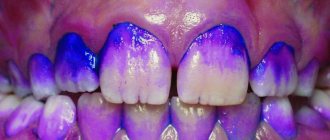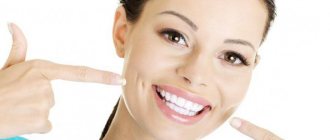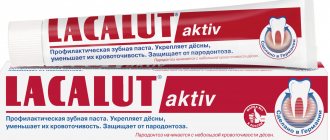If you've run out of toothpaste, don't go shopping, or just want to replace your toothpaste with something else, then you should read this article. It discusses alternative options for brushing your teeth. Making toothpaste at home is easy, and there are also natural remedies.
Girl gnawing vegetables
Why plaque and stone are dangerous
The plaque that settles on the teeth is soft. It can be easily removed with any hygiene products. Within 6-12 hours it reacts with the components of saliva, becomes saturated with calcium salts and hardens. The only way to prevent this is to use mouthwash throughout the day. Once the plaque has hardened, it can no longer be removed.
Tartar gradually forms. It continues to grow as new layers of plaque easily “stick” to the rough surface. After about 6 months it becomes visually noticeable, but this is not its main danger.
The stone grows in the cervical part of the crown, gradually penetrating into the subgingival area. This leads to mechanical damage to the gums and loosening of the teeth. Microorganisms cause gum inflammation and provoke more severe oral diseases. Patients complain of bleeding and sensitivity of the gums, and bad breath. With further growth of the stone deeper into the gums, there is a risk of developing cysts on the root of the tooth.
Oil pulling
Illinois-based Schaumburg Dental Studio recommends oil pulling. The method involves using a teaspoon of oil. Pour into your mouth and rinse. Then we spit it out.
“Oil pulling is believed to remove toxins from the mouth,” says Schaumburg Dental Studio, although the science on this is a little murky.
Coconut and sesame oils are considered the most effective for removing toxins, but sunflower or olive oil can also help.
Cover: fizkes (Shutterstock)
Causes of congestion
- Insufficient oral hygiene, incorrectly selected hygiene products.
- Eating a lot of sweets, sticky foods, rich in light carbohydrates, and at the same time a small amount of solid foods, such as vegetables, in the diet.
- Abuse of products that have a coloring effect. Tea, coffee, cola, carbonated drinks - all this leads to the fact that the plaque turns brownish and, after hardening, spoils the smile.
- Diseases of internal organs. Patients with diseases of the gastrointestinal tract and endocrine system are prone to the formation of plaque on their teeth.
- Partial edentia, malocclusion, severe crowding of teeth.
Patients with bridge prostheses are at risk. The bridge is fixed on the supporting tooth. Food particles get trapped under the crown. In this case, cleaning plaque on teeth with conventional means is impossible. As a result, it grows, microorganisms attack the gums and supporting teeth, and it becomes mobile. If you have dentures, you should definitely visit your dentist for professional cleaning.
Eating vegetables
summerhillmarket.com
Oddly enough, some dentists recommend eating crunchy vegetables instead of regular brushing.
“Fibrous vegetables can act like a brush. When you eat them, biting and chewing can remove food particles and clean your teeth, explain experts at Grace & Leedy Dentistry
In particular, you can use a celery stalk as an alternative toothbrush. You can either simply eat it (if you don’t have toothpaste), or after biting it, tear off the edge and use the stem as a natural toothbrush, applying toothpaste to it.
Types of plaque
- Soft. Formed on teeth during human life. It is not noticeable on the surface of the enamel and is easily removed from it using hygiene products.
- Solid. Once hardened, it is almost impossible to remove plaque from teeth at home.
- Supragingival stone. Formed from hard plaque. Outwardly it looks like a small dark-colored rim in the cervical area.
- Subgingival stone. It is formed under the gum, so it is not visually noticeable. It can only be detected using a special dental probe or an x-ray. If subgingival stone is not removed in time, gum resection may occur.
Ways to brush without a toothbrush
There are situations when there is no brush at hand. For example, after spending the night away from home, you want to freshen your breath, but not everyone will carry a toothbrush with them. However, there are a number of alternative things that can help you brush your teeth without a special brush .
Napkin or paper towel
Ideally, you should use a hard napkin, but if you don’t have one on hand, you can use a regular paper towel or a disposable handkerchief. Algorithm of actions :
- Wrap a napkin around your finger in several layers, wet it slightly and apply toothpaste (if you have it, of course).
- Brush your teeth as if you were using a regular brush.
- You can change the napkin and clean your tongue and gums in the same way.
Siwak tree sticks
These sticks can be ordered online in vacuum packaging, which contains several pieces at once.
In ancient times they were actually used for cleaning and did a relatively good job. One stick can be used for a month.
You just need to adhere to the general storage rules: siwak wood sticks open to prevent mold from forming and store in a non-humid place .
Cleaning her teeth is quite simple - you just need to chew it, after scraping off the bark .
Attention! In “field conditions” you can simply find a 15-20 centimeter stick, peel off the top skin (it should be without hard bark) and use it instead of a toothbrush.
Cleaning with your finger
If you don't have anything at hand, you can use your own finger. First, you need to thoroughly wash your hands , then use your index finger to clean, making circular movements over your teeth and gums .
If you have toothpaste, you can first apply it to your finger.
It is necessary to wash your finger thoroughly when moving from brushing the lower teeth to the upper ones (or vice versa).
Home Remedies
Home remedies for plaque removal are rather preventative. In order to maintain dental health, it is necessary to follow the rules of hygiene:
- Brush your teeth twice a day with a toothbrush and suitable toothpaste.
- Use toothpicks and dental floss after meals, as the brush cannot reach hard-to-reach places.
- Use mouthwash regularly.
Small plaque can be removed using pastes containing abrasives or tooth powder. When using them you need to be careful, as you can damage not only the enamel, but also the mucous membrane of the gums. You need to be even more careful if you decide to remove plaque from your teeth with whitening agents - soda, hydrogen peroxide. Their uncontrolled use can cause problems with dental health.
How to replace toothpaste
From all sources of information, we often hear that toothpaste effectively removes plaque, but do we know by what means? Manufacturers of cheap pastes use calcium carbonate (chalk), which is a coarse abrasive. It scratches the enamel and thins the neck of the tooth. It's even worse if the paste contains aluminum oxide or silicon dioxide. Crystals are the same hardness as tooth enamel, so the benefits are questionable.
American researchers have proven that additives in toothpastes (sodium lauryl sulfate) cause vision changes in children. In addition, they can accumulate in vital organs, in the blood.
For people who do not like to risk their health, a paste with sodium bicarbonate - tooth salt . However, there is also no confidence in its complete safety.
In addition to toothpaste, there are many effective teeth cleaning products. You will need a toothbrush.
In summer, hygienic cleaning can be done using a small currant sprig . It should be peeled from the bark and chewed crosswise. The juice of the branch will help strengthen the gums.
Wheatgrass
Young fresh wheatgrass will also work . After chewing, you will feel the fibers, each of which will cleanse the oral cavity.
Heavy smokers may benefit from using orris root . Due to the harmful effects of nicotine on teeth (their staining), caries develops. The root of this plant will prevent the negative effects of nicotine.
Dry horsetail flour perfectly cleanses and stops bleeding gums. It contains silicon, which strengthens teeth and prevents the development of caries.
Calamus root is suitable as a powder for teeth . The basis of such a “paste” should be clay, to which ground calamus root is added.
Herbal powders will help get rid of bleeding gums.
An alternative to toothpaste can be white clay , it will help remove tartar and strengthen the enamel. To prepare the healing powder, you need to take:
- 60 g white clay;
- 6 tablespoons fine salt;
- 3 tablespoons of soda;
- 3 drops of essential oils (tea tree, orange, mint).
The powder can be stored for a long time and smells pleasant. To use, you need to dip your toothbrush into it and start brushing.
White clay
A good option for cleaning your teeth is table salt . This tool is available anywhere. Salt fights germs in the mouth and strengthens weak gums. Sea salt will be more useful in this case, as it is rich in minerals. Iodine in its composition will have a bactericidal effect.
Using salt, you can prevent rotting processes and eliminate unpleasant odors. Tartar can be defeated with this simple remedy.
The salt should be finely ground. Dip your brush into it and brush your teeth. If you feel any discomfort, add a little vegetable oil to the salt.
If you have sensitive teeth, try a different remedy. Also, do not use salt in the presence of metal fillings - it can cause corrosion.
Baking soda cleans teeth in the same way as salt, but its frequent use can cause irritation of the gums.
Activated carbon can be found in any first aid kit. Due to its abrasive effect, it is often used to whiten teeth.
The method of use is simple: you need to take a couple of tablets, grind them into powder, moisten the brush in the resulting composition and brush your teeth as usual. You should not use charcoal twice a day, as the enamel may gradually become thinner, and this will cause tooth sensitivity.
Activated carbon on teeth
An ancient way to clean enamel is to clean it with ash . If you're a fireplace fan, there's bound to be some ash. If you don’t have a brush at hand, you can rub the soft mixture in with your finger. Your teeth will become clean and snow-white.
Ash, unlike coal, is not just an abrasive. It also has disinfecting properties. It is best to use linden ash. You can add a mixture of herbs to the powder for a pleasant taste.
Paste can be made from strawberries. It contains vitamin C, which will help whiten teeth, cope with plaque, and also keep gums healthy.
If you have healthy teeth, then brushing with water . Oddly enough, using this method you can avoid caries (caries forms on poorly cleaned teeth, and water can wash away food debris).
Strawberry
They also brush their teeth with alum and ginger . You need to take 10% alum and 90% ginger, mix everything and crush it.
Powdered milk is suitable as a replacement for toothpaste. With regular use, you can get rid of bad breath and bleeding gums.
an apple 15 minutes after eating . With the help of fruit acids, the plaque on the teeth softens, and then it’s up to an ordinary brush.
Wheat bran and sulfur are also used to clean teeth.
It is also common to use laundry soap to clean the mouth. However, this method is suitable for few due to the unpleasant aftertaste and odor in the mouth. For this reason, the use of soap is possible for such purposes, but there are more pleasant means.
Wood ash
What can you use to brush your teeth instead of toothpaste? An ancient folk method is the use of ash. In nature, cooled coals should be taken from the fire. The substance is ground into powder. Add a couple of drops of water until a thick, paste-like consistency is formed. The product is applied to the finger and passed over the surfaces of the teeth. Finally, rinse your mouth with plenty of water. As a result, the enamel gets rid of accumulated plaque and becomes clean and snow-white.
Wood ash is more than just an abrasive. The product contains potassium, calcium, phosphorus, manganese, iron. The complex of these elements creates a special environment in the oral cavity that is not suitable for the active reproduction of pathogenic microorganisms. If you add ground mint leaves to a paste prepared from ash, you can get a product with a pleasant taste and aroma.
Healing herbs
When looking for effective folk remedies for cleaning teeth, you should pay attention to plants such as mint, sage, calamus root, thyme, and cloves. These herbs are combined in equal proportions and ground to a powdery consistency. The resulting product is applied to a moistened brush. Perform delicate teeth cleaning. Using the method allows you to remove plaque, disinfect the oral cavity and improve the condition of the gums.
What is professional teeth cleaning?
This is the mechanical removal of any plaque from all surfaces of the teeth. Hygiene does not in any way change the color of the enamel itself, but can return it to its natural whiteness. There are two main methods of professional cleaning:
- Air Flow - supplying a thin stream of water-soda solution under pressure. Removes soft plaque, there are almost no contraindications.
- Ultrasound cleaning is the effect of ultrasound on tartar. The sound seems to “split” it without causing harm to the enamel. If dental structures are installed, cleaning is contraindicated - ultrasound can damage the adhesive connections. But it is easy to carry out partially, in certain areas of the dentition.
These two types of cleansing are not alternatives, as is sometimes suggested in VHI programs. They are intended for different purposes and are performed sequentially in one appointment.
Here are 5 reasons why ultrasonic cleaning and Air Flow are indispensable procedures for everyone who cares about their teeth.
Air Flow does not lighten enamel, but completely cleans teeth
Tartar can only be removed in a clinic
Gradually, the plaque hardens, mineralizes and turns into tartar. In addition to the fact that teeth acquire an unpleasant yellowish tint near the roots, the stone contributes to the growth of soft plaque, potentially increasing the risk of gum pocket inflammation and periodontal disease.
Tartar removal: before and after
While soft plaque is difficult to remove at home, tartar is impossible. Even abrasive pastes, for example, based on salt or coal (these are sold in lines of “natural” cosmetic products), will not affect it in any way.
Kitchen salt
The mineral substance is known for its disinfecting properties. Thanks to its crystalline structure, the product perfectly cleanses plaque from tooth enamel. The effect of salt on the gums reduces the likelihood of developing inflammatory and putrefactive processes. The oral cavity gets rid of unpleasant odor.
You can use sea salt to clean your teeth. The product is a source of a wide range of microelements: iodine, manganese, phosphorus, calcium, silicon, iron. The noted elements have an antiseptic effect on the tissues of the oral cavity.
How to brush your teeth without toothpaste? The salt is thoroughly ground in a mortar until it becomes dusty. Add a couple of drops of vegetable oil. A damp brush is dipped in the substance. Next, teeth are brushed according to the usual principle. Finally, the oral cavity is thoroughly rinsed with water.

